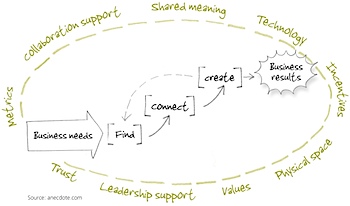Blog
Subscribe
Join over 5,000 people who receive the Anecdotally newsletter—and receive our free ebook Character Trumps Credentials.
Categories
- Anecdotes
- Business storytelling
- Collaboration
- Communication
- Corporate Storytelling
- Culture
- Decision-making
- Employee Engagement
- Events
- Fun
- Insight
- Leadership Posts
- News
- Podcast
- Selling
- Strategy
Archives
- March 2024
- December 2023
- November 2023
- October 2023
- September 2023
- August 2023
- July 2023
- June 2023
- May 2023
- April 2023
Years
Collaboration framework
Organisations need simple ways to create a common understanding about what needs to be done. Our collaboration framework aims to provide two perspectives: the dashed oval represents the collaboration environment—the container that enables (or disables) collaboration within and between organisations; and a simple process reminding us that in business we must collaborate with a purpose, starting with business needs and resulting in outcomes.
I’ll leave the elements of the collaboration environment for another post but let me describe the process.
Business needs—it’s easy to say yes to collaborations. At first blush they are exciting and hold tremendous promise. Successful collaborations, however, require considerable effort from all parties (if this is not the case you are probably co-operating or co-ordinating) and for this reason you must be confident that the effort supports your strategy. Having a strategy helps you say ‘no’ and for those collaborations you create ensuring they’re aligned with your strategy (personal and/or business) will create confidence that the effort will be worthwhile.
It’s also important to know whether your potential collaborators have a strategy and that the new collaboration is aligned to it because if it isn’t there is a good chance that when things get tough they will abandon ship.
Find—Effort is required finding collaborators which means seeking them out and helping them find you. Your ability to find collaborators has a lot to do with your personal network and probably the simplest technique is to tell people what you are interested in and that you don’t have all the pieces of the puzzle. You friends, colleagues and acquaitences will suggest collaborators—business matchmakers setting you up for a blind date. So networking is a key skill. The flip side involves doing things so people can find you and what you are interested in. Can people find you on Google? Is your work well known? Are you doing good work that will attract collaborators. Do you have an attractive demeanour?
Connect—You have to spend time getting to know your collaborators beyond the superficial understanding of title, career highlights and business ambitions. Eating together seems important. And sharing experiences beyond what’s merely required to get the job done. You need to know your collaborators care about you. A few weeks back I started a new collaboration with a graphic facilitator Jock MacNeish. He was heading off on a trip to Italy with his wife and before he left I mention that my wife had to spend a couple of days in hospital. A week after Jock left for Italy I received a postcard from him passing on his best wishes for Sheenagh and hoping all was well. It was a small gesture that meant a lot.
Create—This is where value is created from the collaboration: when you create something together. During this time a range of personal skills are needed: how to keep the collaborators in dialogue even when the conversation is tense; how to break out of established patterns of thinking and behaving to create something new; how to apologise when you stuffed up (here are seven personal skills I think are important for collaboration).
Business results—Finally how do assess the impact of your collaboration? This will depend on what you are working on. In some cases you will have the benefit of being able to measure your impact in terms directly relevant to the business (increased revenue, lower cost, lower risk, greater profit) but in many cases you will need to take an indirect route. Narrative techniques such as Most Significant Change or our Three Journey’s approach can be applied as effective evaluation techniques.
Lynda Gratton from the London Business School recently conducted an investigation of 55 organisations to learn about the behaviours that made the greatest impact on building a collaborative culture. In her Harvard Business Review article she and her co-author list eight. There were two that stood out for me:
- Leaders who modelled collaboration had collaborative organisations
- HR departments had the biggest impact on collaboration if they provided skills training in collaboration and fostered informal learning communities
We are seeing Gratton’s findings playing out here in Australia in that we are currently busy conducting collaboration skills training for organisations, mentoring leaderships teams and continuing our work to foster communities of practice.
Gratton, L. and T. J. Erickson (2007). “8 Ways to Build Collaborative Teams.” Harvard Business Review November: 101-109.
About Shawn Callahan
Shawn, author of Putting Stories to Work, is one of the world's leading business storytelling consultants. He helps executive teams find and tell the story of their strategy. When he is not working on strategy communication, Shawn is helping leaders find and tell business stories to engage, to influence and to inspire. Shawn works with Global 1000 companies including Shell, IBM, SAP, Bayer, Microsoft & Danone. Connect with Shawn on:
